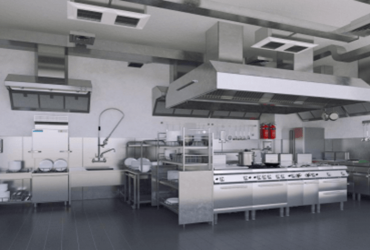How to Set Up a Commercial Kitchen
A commercial kitchen is busy area tending to a large number of customers and is often crowded at most times with several employees managing different aspects of food preparation, handling and delivery. So, if you’re looking to set up a commercial kitchen then you must model it based on the type of clientele you intend to serve and the menu you are offering.
Designing a productive kitchen layout comes with deep understanding of functionality, speed of services and kitchen equipment. Making use of the right resources and keeping your needs in mind along with anticipating your future demands, you’re set to assemble a place that will not only be operationally friendly but will also prove cost effective in the long run. The fist right step in this direction is employing the services of a restaurant interior designer expert who also has experience in planning different types of kitchens.

What are the Essential Components to Consider When Drawing Up a Commercial Kitchen Layout Plan?
Because, your kitchen layout and its miscellaneous features are going to play a significant role in determining how seamlessly your kitchen operates, your design should allow the food to flow seamlessly from the prep area to the service line and blend solid commercial kitchen design principles and cooking components effectively.
However, to begin with, the basic things that need to be checked are:
- Free space availability and easy workflow area for personnel
- Allocated washing/ cleaning area
- Convenient and functional storage space
- Meal preparation area
- Cooking aisles
- Ventilation
- Dynamic service stations
- Free Space Availability and Easy Workflow Area for Personnel
Kitchens are crowded, stuffy and people are in a constant hustle to get work done and therefore, it is essential that there is enough space for people to maneuver without banging in to each other or encounter any untoward accidents. So, an efficient designer working on the kitchen layout will productively use all the area available to ensure that there is enough free space for the staff to not only communicate but also harmoniously go about accomplishing their tasks without stepping on others’ toes.
Also, an ergonomic kitchen design that helps the staff complete a task faster and with fewer steps or ensure that all of the restaurant equipment that chefs need are positioned exactly where they need them will make the kitchen layout elegant, cost effective, and time saving along with improving employee productivity and satisfaction.
- Allocated Washing/ Cleaning Area
Kitchens get messy and the high vortex of action can lead to the place becoming chaotic. Sectioning and positioning the areas by functions can make work flow without hurdles. For example, the cleaning and washing section should be located near the kitchen entrance so that dirty dishes can be offloaded without them being brought into the kitchen and near the storage area allowing clean dishes to be easily stacked and be ready for use.
- Convenient and Functional Storage Space
The storage area can be set up in one of the recesses of the kitchen space and should be divided into non-perishable storage, cold storage, and dry storage sections. This will ensure that the storage area does not eat up the working space of the kitchen and at the same time is easily accessible to the staff since supplies are all available in a designated area. Liquor storage has to be in a dedicated lockable space and has to follow local excise mandatory laws.
- Meal Preparation Area
This area is the prep stage for your meal and should accommodate sinks to wash the raw foods as well as have clean cutting sections and mixing areas. Allocating this place close to your storage area ensures that chefs can have quick access to the stuff they need and don’t have to hunt for ingredients or other cutlery to get their meal ready.
- Cooking Aisles
Because, the meal cooking area is the focal point of your kitchen where main dishes are being prepared, you must install your bulky equipments like ranges, ovens, and fryers in this section. However, do bear in mind that your layout should be designed depending on the type of service you intend to follow and there are 4 basic types of cooking aisle layouts that you can adapt and customize to suit your kitchen.
- Island-Style Layout
The meal cooking area takes center stage here and other sections of the kitchen are placed at the periphery following a particular work order so as to follow a circular flow. This layout is normally adapted in large kitchens as it offers plenty of open floor space and easy communication between different working personnel.
- Zone-Style Layout
In this format, the kitchen is partitioned in blocks with major equipment located along the walls.
The sections follow a sequence keeping the workflow in mind and work tables are designed with respect to the operations performed in the kitchen (cleaning, cutting, mixing, etc). Each zone is made independent by adding equipment that is necessary for the most effective performance of operations (garbage bins, mixers, knives, etc)
- Assembly line configuration
This layout is ideal for restaurants that have a limited menu and need to quickly cater to a large quantity of people, like cafeterias or correctional facilities. In this design format, kitchen equipment is organized linearly starting with the food preparation area and ending with the service station. This arrangement allows cooks to quickly send food down the line. The other sections such as cleaning/washing and storage are located behind the assembly line to keep the workflow uncluttered.
- Ergonomic kitchen configuration
This layout is customized to accommodate every piece of the kitchen with comfort and effectiveness so that most tasks are completed in the shortest amount of time and with the least amount of energy spent.
Ergonomic design even extends to other kitchen utilities and aspects such as lighting and ventilation.
- Ventilation
The kitchen atmosphere can get quite stuffy and hot with different kinds of dishes being cooked. Even, the air quality can get dense with different odors emanating from every quarter adding to the density. Therefore, it is vital that there is proper ventilation to offset the rising temperatures. Air balancing is very important for the smooth functioning of equipment as well as staff. Also product quality improves with the correct exhaust and fresh air balance. This obviously needs to be done through your experienced designer. The designer needs to do a heat load calculation to decide what capacity of fresh air machine and exhaust machine are to be used. By law, you’re not allowed to exhaust untreated air. The exhaust fumes need to be cleaned by either a scrubber air washer. A point to note is that you must make sure you’ve checked all the safety codes necessary in installing and maintaining the different aspects of your restaurant. An experienced interior designer could help you address these concerns as well.

- Service Stations
The service area is the concluding section of a commercial kitchen. Your stewards will pick up finished dishes from here to take to customers or if you have a buffet-style restaurant, the service stations will display the food for customers to assemble their plates. This area can be tweaked depending on the space available and if it is customer facing then the arrangement and layout can make a distinct impression on your clientele. You can also opt for mobile service stations if you lack space, otherwise this area is best located at the very front of the kitchen, to shorten the distance between completed meals and customers.
These are some of the tips you should consider if you intend to set up a commercial kitchen and to make matters simple, employ a professional designer to plan your commercial kitchen, so that you’re assured that all aspects of the building and health department rules are covered. The kitchen area is the crux of any restaurant and if you’ve not planned this place well you’re going to be hard pressed to provide excellent food in a timely manner. Therefore meticulous planning and investing in the right equipment, layout, and other kitchen accessories is absolutely necessary. Sprinteriors, your interior designing partner can offer you valuable advice with the latest trends and services that will lend your venture the much needed boost to make your venture a successful enterprise. Therefore, to get up and running swiftly, connect with us at www.sprint-co.com now.



 Back to Blogs
Back to Blogs

 Prev
Prev

